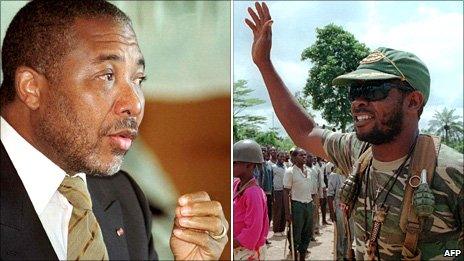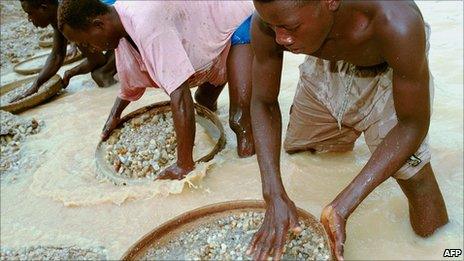Charles Taylor: Godfather or peacemaker?
- Published

As the judges in the war crimes trial of former Liberian President Charles Taylor consider their verdict, two conflicting pictures have been drawn.
One is of a warlord who was "The Godfather" in Sierra Leone's brutal civil war.
The other is of a peacemaker who was the victim of an international political conspiracy.
For more than three years, Mr Taylor has been on trial in The Netherlands, the first former African head of state to face an international tribunal.
Inside the Special Court for Sierra Leone at Leidschendam, Mr Taylor's face has been utterly expressionless.
Liberian cufflinks
He has been seated behind his team of defence lawyers, occasionally scribbling notes in a leather-bound booklet.
As his trial drew to a close this week, Mr Taylor was favouring a pair of cufflinks bearing the Liberian flag.
The case has had added significance in light of the crisis in Libya, and the recent decision of the International Criminal Court to investigate Colonel Muammar Gaddafi and his inner circle.
The clear message is that impunity will no longer be tolerated.
Mr Taylor's defence lawyer, Courtenay Griffiths, fully supports that ideal.
He has said this trial was "of importance to Africa and to this evolving concept of international justice".
Nonetheless, Mr Griffiths believes his client was unfairly targeted, and that the prosecution of Mr Taylor has been selective.

The defence has tried to show the late rebel leader Foday Sankoh secured weapons
"Why is Colonel Muammar Gaddafi not in the dock?" Mr Griffiths asked.
Prosecutors allege that Mr Taylor was the key figure during the conflict in Sierra Leone, and that he was directly responsible for the attacks carried out on the civilian population.
In closing arguments, the prosecution said there was evidence to show that the former leader of Sierra Leone's RUF rebels, Foday Sankoh, had been "a subordinate" to Mr Taylor, not "an equal", as claimed by the defence.
'Witnesses paid'
Mr Taylor faces 11 counts of war crimes and crimes against humanity, but denies all the charges.
The defence has alleged the prosecution of Mr Taylor has been politically motivated.
Mr Griffiths has said the publication of leaked US diplomatic cables last December, external confirm that the United States wanted Mr Taylor "put away for a long time".

Sierra Leone is rich in diamonds which it is alleged the rebels traded for arms
As far back as 2002, the then-president of Liberia believed that "some powerful countries were out to get him".
The defence has also accused prosecutors of paying some witnesses generously for their co-operation.
The court was told that in 2008, one potential witness apparently received more than $3,000 (about £1,900) from prosecution funds.
"This money has been used to pollute the pure waters of justice," a defence lawyer argued.
Contradictory testimony
The judges will have to review more than three years of evidence as they try to reach a decision on whether Mr Taylor is guilty.
That includes the often contradictory testimony provided last year by supermodel Naomi Campbell, Hollywood actress Mia Farrow and Ms Campbell's former agent, Carole White.
They were all called to give evidence about the gift of diamonds which Ms Campbell received in South Africa in 1997, hours after she met Mr Taylor at a dinner hosted by Nelson Mandela, when he was South Africa's president.
However, the alleged involvement of Libya in the Sierra Leone narrative has been an intriguing and topical element in this final phase of the trial.
It has been claimed that Mr Taylor received military training in Libya in the late 1980s before he launched his armed invasion of his homeland in 1990.
In later years, there were allegations of arms shipments from Libya, destined for Sierra Leone.
The court also heard how Sankoh had written a letter to a Libyan diplomat in Ghana in 1996, thanking him for the sum of $500,000 for military materials.
In the style of a 411 scam letter, Sankoh also made a plaintive plea for a further $1.5m.
The defence used this evidence to try to show that it was Sankoh, not Mr Taylor who was involved in securing weapons for use in Sierra Leone.
For that remains the central question.
Was Mr Taylor the man bearing the greatest responsibility for the Sierra Leone conflict?